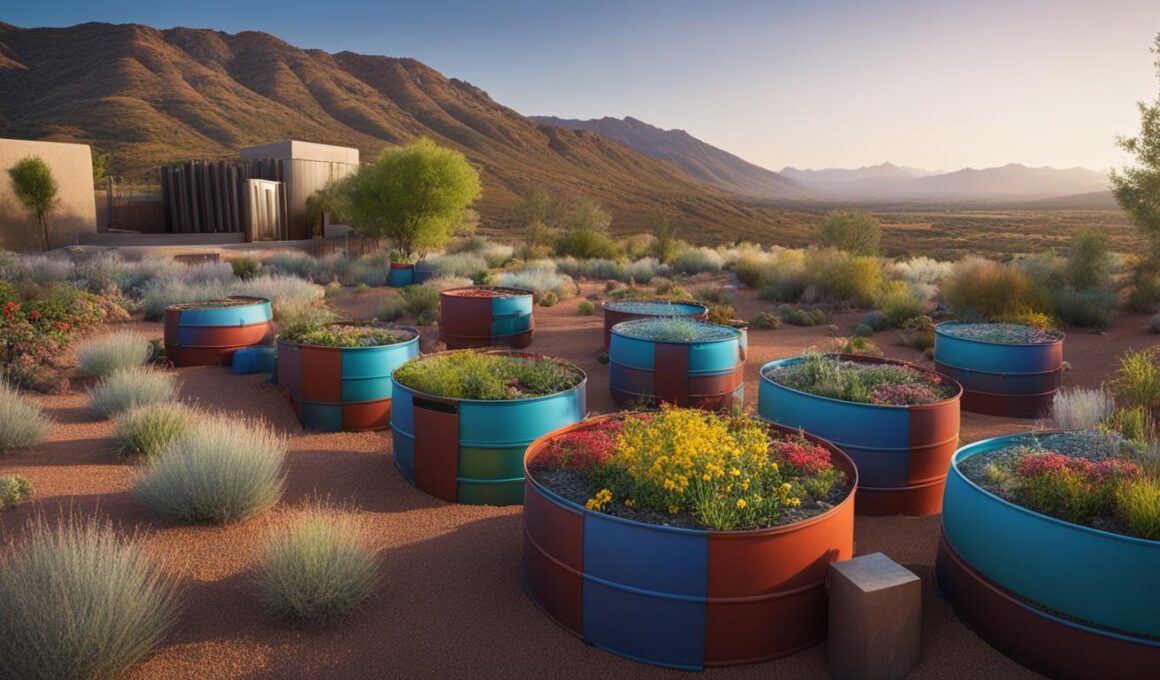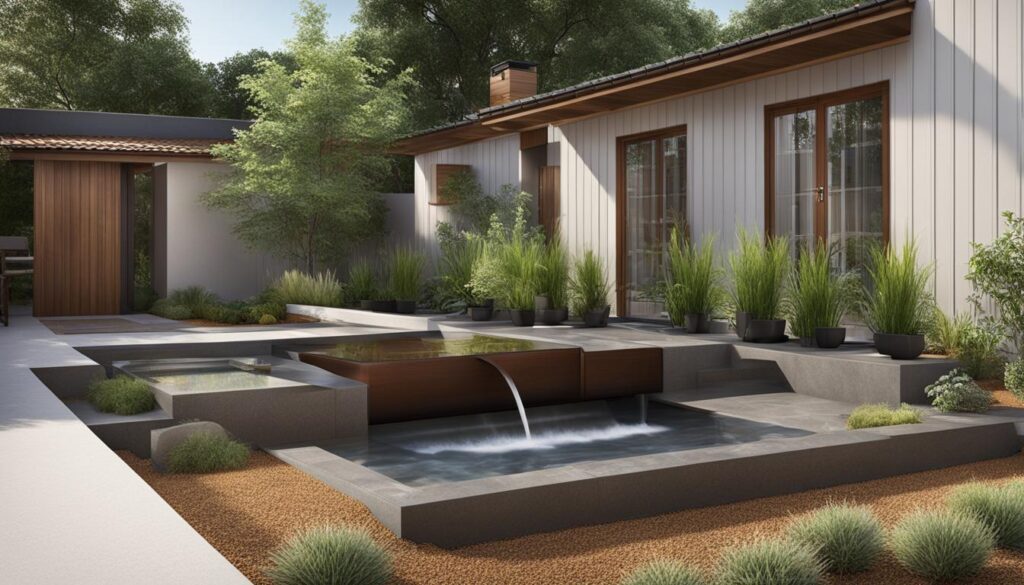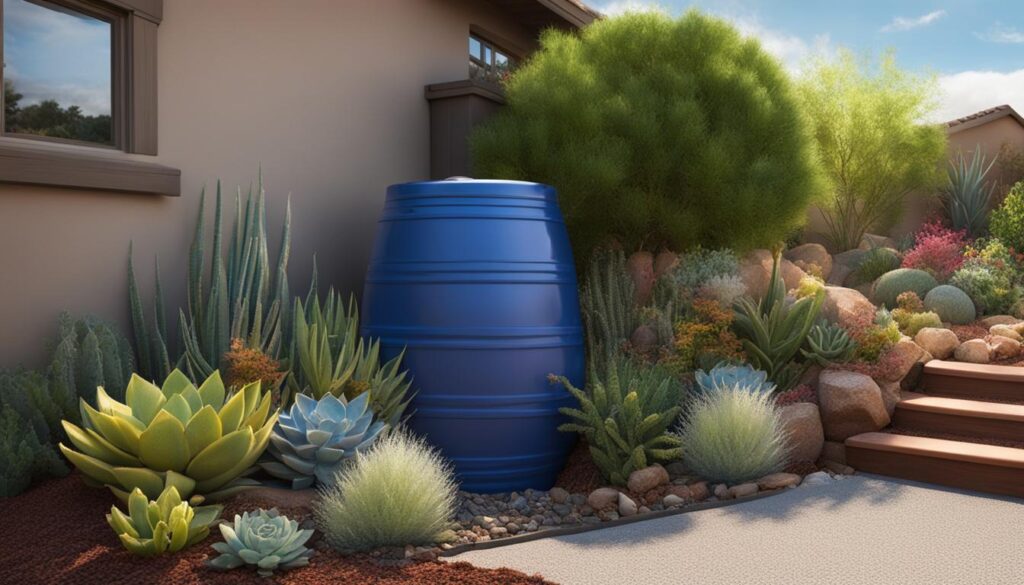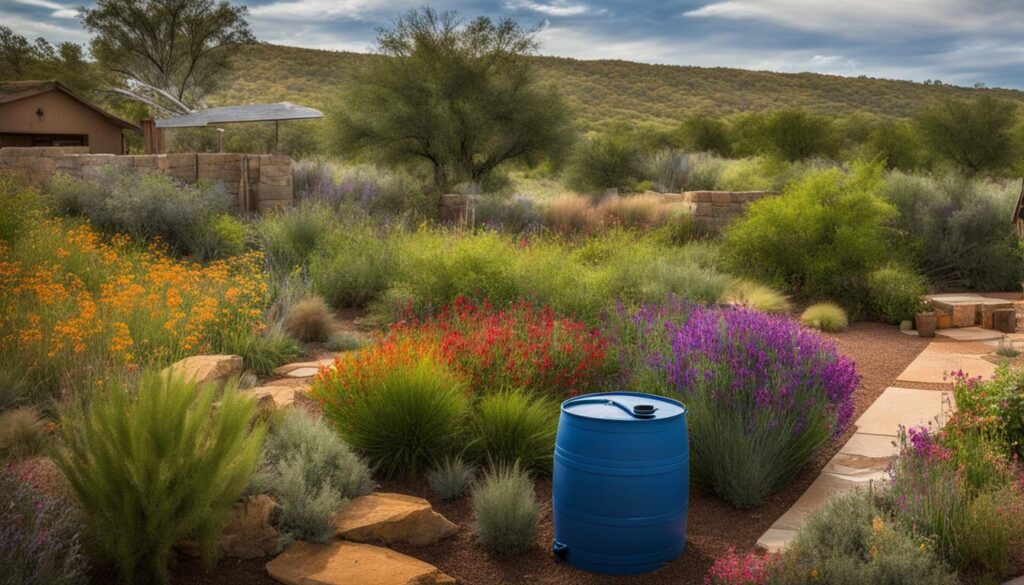Are you looking for a way to save water and lower your bills while maintaining a beautiful landscape? Consider rainwater harvesting for xeriscape irrigation. With this environmentally friendly practice, you can harness the power of rainwater to nourish your plants and reduce your reliance on traditional water sources. Let’s explore how rainwater harvesting can benefit your xeriscape garden.
Key Takeaways:
- Rainwater is a valuable resource for irrigating xeriscape landscapes, as it is free of salts and chemicals.
- Techniques like bioswales, detention basins, and rainwater cisterns can be used to harvest and utilize rainwater effectively.
- Rainwater harvesting helps save water, lower bills, and contribute to sustainable irrigation practices.
- Consider factors like storage options, costs, planning, and calculation of rainwater supply and irrigation demand.
- Proper filtration, pump selection, and backup water resources ensure efficient and reliable rainwater harvesting for your irrigation system.
Bioswales and Detention Basins
Bioswales and detention basins are effective techniques for rainwater harvesting and can play a crucial role in reducing runoff and controlling erosion. These passive systems allow for the maximum utilization of rainfall by capturing roof water and stormwater and directing it to specific zones in the landscape. One of the key advantages of bioswales and detention basins is their ability to promote deeper infiltration, which is beneficial for the growth of deep-rooted plants and trees.
Bioswales are visually appealing features that can be integrated into the landscape design. They often incorporate natural elements such as rocks and plants, creating an aesthetically pleasing addition to the surroundings. On the other hand, detention basins are concealed underground and utilize gravel leach fields to store and slowly release the captured water. Both bioswales and detention basins effectively reduce runoff and prevent erosion, making them valuable components of rainwater harvesting systems.
Benefits of Bioswales and Detention Basins:
- Reduces runoff and prevents erosion
- Provides deep watering to trees during drought years
- Promotes the growth of deep-rooted plants
- Enhances the visual appeal of the landscape
“Bioswales and detention basins are essential components of rainwater harvesting systems, offering both functional and aesthetic benefits.” – Rainwater Harvesting Expert
To fully harness the benefits of bioswales and detention basins, it is important to design them in a way that optimizes their efficiency. Proper planning, including the consideration of factors such as slope, soil type, and vegetation, is essential for ensuring effective rainwater capture and infiltration. Consulting with a landscape designer or rainwater harvesting expert can provide valuable insights and guidance in incorporating bioswales and detention basins into your overall landscape design, effectively utilizing rainwater for irrigation purposes.
Rainwater Cisterns
Rainwater cisterns are an efficient and practical solution for harvesting rainwater to supplement irrigation needs. By collecting water from your roof and storing it in a cistern system, you can harness the full potential of rainwater for later use. This sustainable approach not only helps conserve water but also reduces your reliance on municipal water sources, leading to cost savings and environmental benefits.
Roof collection plays a crucial role in rainwater cistern systems. As rain falls on your roof, it flows into gutters and downspouts, which can be connected to the cistern system through pipes. By ensuring proper filtration, you can remove debris and contaminants from the collected rainwater, improving its quality for irrigation purposes.
The storage capacity of rainwater cisterns depends on various factors, such as the size of your roof, average rainfall, and water demand for irrigation. For example, a 3,000 square foot roof can collect approximately 1,870 gallons of water from just 1 inch of rainfall. Over the course of a winter, this can add up to an impressive 24,000 to 37,000 gallons. With such substantial water storage capabilities, rainwater cisterns provide a reliable and consistent supply of water for your irrigation needs, even during dry seasons.
Benefits of Rainwater Cisterns:
- Conserves water by utilizing a free and renewable resource
- Reduces reliance on municipal water supplies, leading to cost savings
- Improves the health and vitality of plants with natural, chemical-free water
- Reduces stormwater runoff and erosion by capturing rainwater on-site
- Enhances sustainability and environmental stewardship
Implementing a rainwater cistern system requires careful consideration of factors such as storage capacity, filtration methods, and pump selection. Consulting with a professional can help you design and install a system that meets your specific needs and ensures efficient water utilization for your landscape irrigation.
Options and Costs
When considering rainwater harvesting systems for your xeriscape irrigation, it’s important to explore the available options and their associated costs. The two primary components to consider are storage tanks and rain barrels, each with their own advantages and price points.
Storage Tanks:
| Tank Type | Material | Storage Capacity | Cost per Gallon* |
|---|---|---|---|
| Above-ground | Plastic | 5,000 – 40,000 gallons | $2 – $5 |
| Underground | Concrete | 10,000 – 100,000+ gallons | $7 – $10+ |
(*Installation costs are not included in the cost-per-gallon figures)
Storage tanks are suitable for larger rainwater harvesting systems and offer long-term reliability. Above-ground tanks made of plastic are the most common and cost-effective option. They are available in various sizes and shapes, making them adaptable to different spaces. Underground concrete tanks provide larger storage capacity but come with higher installation costs due to excavation and construction requirements.
Rain Barrels:
Rain barrels are a budget-friendly option for smaller-scale rainwater harvesting. They are typically made of plastic and can hold around 50-100 gallons of water. The cost of a rain barrel ranges from $50 to $150, depending on the size and features. Rain barrels are easy to install and can be connected to downspouts to collect water directly from the roof. They are ideal for homeowners with limited space or those looking for a cost-effective solution.
(Image source: www.example.com)
When planning your rainwater harvesting system, carefully evaluate your storage needs and budget constraints. Consider factors such as available space, desired storage capacity, and long-term maintenance costs. Whether you choose storage tanks or rain barrels, both options can help you save water and lower your irrigation expenses while promoting sustainable water practices for your xeriscape landscape.
When to Plan
Planning is a crucial step in the process of rainwater harvesting for irrigation. By carefully considering the timing of your project, you can ensure efficient installation and optimal results for your landscape. It is advisable to start thinking about your rainwater harvesting system during the wet season, when rainfall is abundant. This allows for proper design and planning, with installation taking place during the dry season.
It is recommended to allow 3-8 months for the design and installation process, depending on the complexity of your system and any necessary permits or approvals. Rushing decisions can lead to suboptimal outcomes, so taking the time to carefully plan your system is essential. Consulting with a landscape designer can provide valuable insights and help you incorporate the rainwater harvesting system seamlessly into your overall landscape plans.
Benefits of Strategic Planning
Strategic planning for rainwater harvesting offers several benefits. By planning during the wet season, you can take advantage of natural rain events to assess water flow patterns and identify the most suitable locations for collection and storage. Additionally, designing your system during the dry season gives you ample time to research and select the appropriate equipment, ensure site readiness, and coordinate with contractors if necessary.
By planning ahead, you can also take into account any landscaping changes or modifications that may be needed to accommodate the rainwater harvesting system. This includes considering the siting of rain barrels or cisterns, as well as any adjustments to existing irrigation systems to connect with the harvested water. Taking a holistic approach to your landscape design and rainwater harvesting system will help you achieve the most efficient and effective results.
Installation Timeline
The installation timeline for a rainwater harvesting system can vary depending on factors such as system complexity, site conditions, and local regulations. It is important to allow sufficient time for any required permits, inspections, or contractor availability. A typical installation process can take anywhere from a few days to several weeks, depending on the scope of the project.
During the installation process, it is important to work with experienced professionals who can ensure proper system setup and functionality. This includes correctly positioning collection structures, installing filtration systems, and ensuring proper connections to irrigation systems or storage tanks. By following the installation timeline and working with knowledgeable experts, you can have confidence in the successful implementation of your rainwater harvesting system.
Capture Rainwater with Rain Barrels
Rain barrels provide an easy and affordable way to capture rainwater for year-round landscape irrigation. With their simple installation and numerous benefits, rain barrels are a popular choice for homeowners looking to save on water bills while conserving water resources.
One of the key advantages of rain barrels is their ease of installation. They can be easily connected to downspouts, allowing rainwater to be diverted directly into the barrel. The barrels themselves are available in various sizes, so you can choose the capacity that suits your needs. Additionally, rain barrels can be discreetly placed in your landscape, ensuring a seamless integration with your outdoor space.
Using rain barrels for irrigation offers several benefits. Firstly, it helps to reduce water bills by utilizing a free, natural water source. Secondly, rainwater is ideal for plants as it is free of chlorine and other chemicals commonly found in tap water. This promotes healthier growth and reduces the risk of plant damage. Lastly, rainwater harvesting through rain barrels contributes to water conservation efforts by reducing the demand for treated water from municipal sources.
Benefits of Rain Barrels for Irrigation:
- Easy installation and connectivity to downspouts
- Cost-effective solution for year-round irrigation
- Promotes healthier plant growth with chemical-free water
- Reduces water bills by utilizing a free water source
- Contributes to water conservation efforts
Rain barrels provide an affordable and sustainable way to capture rainwater for irrigation purposes. By installing rain barrels, you can not only save on water bills but also contribute to water conservation and promote the health of your plants.
| Benefits | Explanation |
|---|---|
| Easy installation | Rain barrels can be easily connected to downspouts, making installation a hassle-free process. |
| Cost-effective | Using rainwater from barrels reduces the need for treated water, resulting in significant savings on water bills. |
| Healthier plants | Chemical-free rainwater promotes the overall health and vitality of plants, reducing the risk of damage or disease. |
| Water conservation | By utilizing rainwater, you are reducing the demand for treated water, contributing to sustainable water usage. |
Rainwater Harvesting for Irrigation in Texas
Rainwater harvesting serves as an affordable water source for landscape irrigation in Texas, offering a sustainable solution for conserving water and reducing reliance on traditional water supplies. With the state experiencing population growth and increasing development, capturing rainwater has become even more crucial in alleviating strain on municipal water sources and delaying the construction of new treatment plants.
In Texas, rainwater harvesting is widely used for various purposes, including irrigation, topping up ponds and pools, supplying water for greenhouses, and meeting the needs of livestock and wildlife. Both large-scale systems and smaller residential setups are viable options for meeting irrigation demands while promoting landscape water conservation.
Implementing a rainwater harvesting system in Texas not only provides an affordable water source for irrigation but also contributes to environmental preservation. By using rainwater instead of relying solely on traditional water supplies, individuals can actively participate in protecting the environment and promoting water sustainability.
Rainwater Harvesting Supply Calculation
Calculating the supply of rainwater is crucial for determining the feasibility and potential of rainwater harvesting systems for irrigation purposes. The supply can be calculated by considering the catchment area and the amount of rainfall received. To accurately calculate the potential supply, you need to know how much water can be collected from every square foot of the catchment area for a given amount of rainfall.
For every square foot of imperious surface, a 1″ rainfall can collect approximately 0.623 gallons of water. This means that the collected water will vary based on the size of the catchment area and the amount of rainfall received. To calculate the potential supply, multiply the catchment area in square feet by 0.623 and then multiply the result by the amount of rainfall in inches. This will give you an estimate of the total gallon collection for irrigation purposes.
For example, if you have a catchment area of 1,000 square feet and there was a rainfall of 1 inch, the calculation would be as follows: 1,000 (catchment area) x 0.623 (gallons per square foot) x 1 (rainfall in inches) = 623 gallons. This means that you would potentially collect 623 gallons of rainwater for irrigation purposes.
Table: Rainwater Supply Calculation
| Catchment Area (sq ft) | Rainfall (inches) | Gallon Collection |
|---|---|---|
| 1,000 | 1 | 623 |
| 2,000 | 0.5 | 623 |
| 3,000 | 2 | 3,738 |
| 4,000 | 0.75 | 2,359 |
The table above provides examples of rainwater supply calculations for different catchment areas and rainfall amounts. It demonstrates how the gallon collection varies based on these factors. By calculating the potential supply, you can determine the feasibility of a rainwater harvesting system for your irrigation needs and make informed decisions about its implementation.
Rainwater Harvesting Demand Calculation
When implementing a rainwater harvesting system for irrigation, it is important to calculate the demand for water accurately. This involves considering several factors, including plant water requirements, evapotranspiration, and the size of the landscaped area. By understanding these variables, you can determine the amount of water needed and assess whether rainwater harvesting can meet the demand effectively.
Plant water requirements vary depending on the type of plants in your landscape. Different plants have different water use coefficients, which represent their water needs relative to reference evapotranspiration. For example, grass typically has a water use coefficient of 1, meaning it requires the same amount of water as the reference evapotranspiration. Understanding the water needs of your plants will help you calculate the irrigation demand accurately.
Evapotranspiration refers to the combined loss of water through evaporation from the soil and transpiration from plants. It is influenced by factors such as temperature, humidity, wind speed, and solar radiation. By considering evapotranspiration rates specific to your region, you can estimate how much water your plants will require to thrive.
In addition to plant water requirements and evapotranspiration, the size of the landscaped area also plays a crucial role in demand calculation. A larger area will typically require more water for irrigation. By assessing the size of your landscape, you can determine the overall water needs and ensure that your rainwater harvesting system can meet the demand adequately.
Calculating the irrigation demand accurately is essential for designing an efficient rainwater harvesting system. By understanding plant water requirements, evapotranspiration rates, and the size of the landscaped area, you can make informed decisions about the capacity of your system and its ability to meet your irrigation needs.
Table: Plant Water Use Coefficients
| Plant Type | Water Use Coefficient |
|---|---|
| Grass | 1 |
| Trees | 0.5-0.7 |
| Shrubs | 0.4-0.6 |
| Perennials | 0.3-0.5 |
Table: Plant Water Use Coefficients
Filtration, Pump, and Back-Up Water
In order to ensure the efficient and reliable use of rainwater for irrigation, it is important to consider filtration, pump selection, and backup water options. Filtration plays a crucial role in removing debris and particles from rainwater before it is stored and distributed. Clean gutters and the installation of filters help maintain the quality of the harvested water, ensuring that it is suitable for irrigation purposes.
When it comes to pump selection, it is essential to choose a pump that meets the pressure requirements for proper irrigation. Different irrigation systems have different pressure needs, so selecting the right pump will help ensure that the rainwater is distributed effectively throughout the landscape.
In situations where the catchment area may not provide sufficient rainwater, having a backup water source is important to supplement the irrigation needs. This can include alternative water sources such as well water or municipal water. By having a backup water option available, you can ensure that your irrigation system always has a reliable water supply, even during periods of low rainfall.
Filtration
“Proper filtration is a vital step in rainwater harvesting. It helps eliminate impurities and ensures that the water is clean and suitable for irrigation. By keeping gutters clean and installing filters, you can maintain the quality of the harvested rainwater.”
– Water Conservation Expert
Pump Selection
“Choosing the right pump is crucial for efficient irrigation. Consider the pressure requirements of your irrigation system and select a pump that can meet those needs. This will ensure that the rainwater is distributed evenly and effectively throughout your landscape.”
– Irrigation Specialist
Backup Water
“Having a backup water source is essential to maintain irrigation during periods of low rainfall. Consider alternative water sources such as well water or municipal water to supplement your rainwater supply. This will help ensure that your irrigation system always has a reliable water source.”
– Water Management Consultant
Conclusion
Rainwater harvesting offers a multitude of benefits for sustainable irrigation and environmental preservation. By utilizing this method, you can conserve water and lower your water bills while nurturing your landscapes in an environmentally friendly way.
By implementing suitable rainwater harvesting techniques such as bioswales, detention basins, or rainwater cisterns, you can effectively utilize this valuable resource for your irrigation needs. Calculating the supply and demand of rainwater ensures that you make the most of this sustainable water source.
Not only does rainwater harvesting contribute to sustainable water practices, but it also plays a crucial role in environmental preservation. By reducing the strain on municipal water supplies and delaying the need for new treatment plants, you can have a positive impact on your local ecosystem.
Incorporating a rainwater harvesting system into your landscape design allows you to play an active role in conserving water, saving money, and promoting a healthier environment. So why wait? Start harvesting rainwater today and see the remarkable benefits it brings to your xeriscape irrigation.
How Can Rainwater Harvesting Be Incorporated into Automated Irrigation for Xeriscaped Lawns?
Rainwater harvesting can easily be incorporated into an automated irrigation system for xeriscaped lawns. By collecting and storing rainwater, the system can then distribute it through the automated irrigation system for xeriscaped lawns, reducing the reliance on traditional water sources and promoting sustainability.
FAQ
What is the advantage of rainwater harvesting for xeriscape irrigation?
Rainwater is a valuable resource that is soft, free of salts and chemicals, and contains nitrogen beneficial for plants. It helps conserve water, reduce water bills, and nurture landscapes in an environmentally friendly way.
What are bioswales and detention basins?
Bioswales and detention basins are passive techniques used to maximize the impact of rainfall. They capture roof water and stormwater and direct it to specific zones in the landscape, allowing for deeper infiltration. Bioswales can be visually appealing with natural features like rocks and plants, while concealed detention basins utilize underground gravel leach fields.
How do rainwater cisterns work?
Rainwater cisterns are the most efficient way to harvest rainwater. By collecting water from roof surfaces and piping it into a storage system, nearly 100% of the rainwater that hits the roof can be transferred for later use. The stored rainwater can be filtered and pumped into an irrigation system, supplementing the water supply during dry seasons.
What are the options and costs for rainwater harvesting?
Rainwater harvesting systems can vary in cost, with storage being a major constraint. Above-ground storage tanks, made of plastic or other materials, are commonly used. Installation costs for a system with a storage capacity between 5,000 and 40,000 gallons range from $2 to $5 per gallon. For those on a budget, rain barrels can be a cost-effective option to harvest water from downspouts.
When is the best time to plan for rainwater harvesting?
Strategic planning is crucial when it comes to rainwater harvesting. It’s advantageous to start thinking about the system during the wet season, allowing for proper design and installation during the dry season. Allowing 3-8 months for design and installation without rushing decisions is recommended.
How can rain barrels be used to capture rainwater?
Rain barrels provide a simple and affordable way to capture rainwater for year-round landscape irrigation. These systems make use of alterations to downspouts, including leaf filters and first flush devices to minimize organic material. Rain barrels can be discreetly placed in the landscape, offering an emergency water supply while conserving water.
What are the benefits of rainwater harvesting for irrigation in Texas?
Rainwater harvesting is an affordable alternative water source for landscape irrigation in Texas. With increasing water costs due to population growth and development, capturing rainwater can reduce strain on municipal water supplies and delay the need for new treatment plants. It is commonly used for various purposes, including irrigation, topping up ponds and pools, greenhouse water, and livestock and wildlife needs.
How do you calculate the supply of rainwater for irrigation?
The supply of rainwater can be calculated based on the catchment area and rainfall. For every square foot of imperious surface, a 1″ rainfall can collect 0.623 gallons of water. The collected water varies depending on the size of the catchment area and the amount of rainfall received.
How do you calculate the demand for irrigation water?
Irrigation demand can be calculated by considering plant water requirements, evapotranspiration, and the size of the landscaped area. Different plants have varying water use coefficients, representing their water requirements relative to reference evapotranspiration. Calculations help determine the amount of water needed for irrigation and whether rainwater harvesting can meet the demand.
What is the importance of filtration, pumps, and backup water in rainwater harvesting?
Filtration is essential to remove debris and particles from rainwater before storage and distribution. Pump selection depends on pressure requirements for proper irrigation. Supplemental water resources may be necessary if the catchment area is insufficient. Connection to the irrigation system involves redirecting the main line to the rainwater supply.
What are the key benefits of rainwater harvesting for xeriscape irrigation?
Rainwater harvesting provides numerous benefits for xeriscape irrigation. It helps conserve water, reduce water bills, and nurture landscapes in an environmentally friendly way. By choosing suitable harvesting techniques and calculating supply and demand, individuals can effectively utilize rainwater for their irrigation needs. Implementing a rainwater harvesting system contributes to sustainable water practices and environmental preservation.














